Homemade Applesauce for Canning {Step by Step}
Homemade applesauce is a cozy, comforting classic that every age loves. Truly! This is a basic canning recipe done right. You’ll love the spices and fresh apple flavor. You’ll also love how much money it saves you.
I’ll walk you through the process. Whether you’re experienced or this is your first canning project, you’ll have a delicious result.
Applesauce For Canning
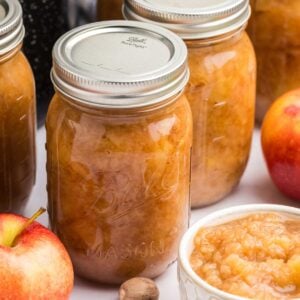
Equipment
- Large pot
- Potato masher or immersion blender
- Canning jars with lids and bands
- Waterbath canner
- Jar lifter and canning funnel
Ingredients
- 10 pounds apples a mix of sweet and tart varieties for best flavor
- 1-2 cups water or apple cider for a richer flavor
- 2 tablespoons bottled lemon juice
- 2 teaspoons ground cinnamon optional
- ¼ teaspoon ground nutmeg optional
- 1-1½ cups sugar optional, depending on the sweetness of the apples
Save This Recipe
You'll join my email list which you will love. And if you don't, unsubscribe in one click. ❤️
Instructions
- Prepare the Apples. Wash, peel, core, and quarter the apples.
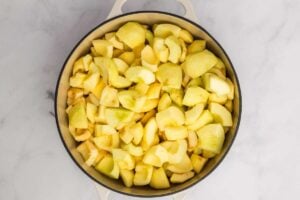
- Cook the apples. In a large pot, combine the apples with water or apple cider. The liquid should just barely cover the bottom of the pot to prevent burning. Bring the mixture to a boil over medium-high heat. Reduce heat to a simmer and cook, covered, until the apples are soft (about 20-30 minutes).

- Add lemon juice and spices. Add lemon juice. Taste the apples and see if they sweet enough. If not, not add sugar. Add spices as desired.

- Mash the Apples. Remove from heat. For chunky applesauce, use a potato masher. For smooth applesauce, use an immersion blender.

- Prepare for canning. Sterilize lids, and bands by boiling them in water for at least 10 minutes. Heat the jars in the waterbath canner. It should be hot but not boiling when jars are added. They do not need to be sterile, just hot.
- Fill the Jars. Using a canning funnel, ladle the hot applesauce into jars, leaving 1/2 inch headspace. Wipe the rims of the jars with a clean, damp cloth. Apply lids and screw on bands until fingertip tight.

- Process the Jars. Return canner to full rolling boil. Place jars in the canner using a jar lifter. Make sure they are covered by at least 1 inch of water. Bring back to a rolling boil and process for 20 minutes (adjust time for altitude if necessary). Turn off heat, remove canner lid, and let jars rest in the canner for 5 minutes.

- Cool and Store. Remove jars from canner and place on a towel to cool for 12-24 hours. Check seals, label, and store in a cool, dark place for up to a year.

Notes
- Avoid Overfilling the Jars: Overfilling can cause food to expand and push out under the lid during processing, leading to siphoning. Always measure the headspace carefully.
- Tighten the Bands Properly: Screw bands should be tightened just to “fingertip tight” — this means as tight as you can get them using just your fingertips, not your whole hand. Over-tightening can prevent air from escaping, leading to siphoning.
- Check for Air Bubbles: After filling the jars and before applying the lids, remove air bubbles by running a non-metallic spatula or bubble remover tool along the inside of the jar. Air pockets can lead to siphoning and affect heat distribution during processing.
- Avoid Rushing the Cooling Process: After processing, allow the jars to cool in the canner for the recommended time before removing them. Rapid cooling increases the likelihood of siphoning.
Nutrition
Did You Make This?
I would love it if you would leave a review!This home-canned applesauce is a perfect way to preserve the natural sweetness and wholesome goodness of apples. It ensures you can enjoy some of auutmn all year round
A Newsletter you’ll love
Daily recipes from the farmhouse, Sunday meal plans, seasonal ideas, straight from my kitchen to your inbox.
I promise to keep your email address safe. Unsubscribe at any time

I hope you love this recipe and enjoy customizing it to your family’s tastes so it becomes perfect for you.
🥣 important tools and ingredients
Unlike many canning recipes, there is some flexibility here. You need the lemon juice for acidity, but the sugar and spices and are all for flavor and are optional.
- Apples. The heart of this recipe lies in its choice of apples. Using a mix of sweet and tart varieties not only enhances the flavor profile but also adds a depth that can’t be achieved with just one type of apple.
- Spices. Cinnamon, nutmeg, and other spices based on your taste preferences. Some people like a small amount of allspice or cloves.
- Sugar. Yes, it is optional! The sweetness of your apples will vary depending on the varieties and sometimes will even change year to year from the same tree. You’ll want to taste every batch. and add however much sugar you think it needs.
- Apple Cider. The use of apple cider as an alternative to water adds a richer, more complex flavor to the sauce.

The equipment you’ll need is pretty basic. If you already can at home you probably have everything. If you don’t, you’ll want all of these. items.
- Waterbath Canner. If you don’t have one, a big stockpot works.
- Lifter and Canning Funnel. These tools are invaluable for safely and efficiently filling and handling hot jars.
- Potato Masher or Immersion Blender. Use a potato masher for more texture, a stick blender if you want.a smoother result.
- Large Pot. It is needed for cooking the apples and preparing the applesauce.
- Canning Jars with Lids and Bands. Wide mouth or regular mouth are both fine.
YYP Apple Peeler Corer, 5 In 1 Apple Peeler Slicer Corer, Durable Heavy Duty Apple Peeler Slicer with Powerful Suction Base and Stainless Steel Blades RedYETTASBIN Apples Flowers Kitchen Dish Towel 4 Pack, Soft Absorbent Dishcloths Reusable Hand Towel Washable Tea Towels for Home Kitchen Bar Table Decor, 28 x 18 InchMRS. MEYER’S CLEAN DAY Kitchen Set Dish Soap, Hand Soap, Multi-Surface Cleaner, 3 CT (Apple Cider)
If you have an apple peeler/ corer that attaches to the counter, it’s worth using for this recipe. Makes prepping your fruit so much easier.
✨ Tips for the best applesauce
For the most success, follow these extra tips.
- Choose the Right Apple Varieties. Research and select a combination of apples that balance sweetness and tartness. Experiment with local varieties for unique flavors.
- Perfect the Texture: Understanding the desired texture of your applesauce is key. Cook the apples longer for a smoother sauce, or reduce the cooking time for a chunkier texture.
- Master the Flavor Balance: Taste your applesauce as you cook. Depending on the natural sweetness of your apples, adjust the amount of added sugar. Remember, you can always add more, but you can’t take it out.
- Understand Canning Safety. Familiarize yourself with the basics of waterbath canning. Focus on sterilization and sealing techniques. This ensures the longevity and safety of your canned applesauce.
- Optimize Your Workspace. Arrange your kitchen efficiently. Have all tools and ingredients easily accessible to streamline the canning process.
- Manage Time Efficiently. Prepare your canning station while the apples are cooking to save time. This includes sterilizing jars and preparing your waterbath canner.
- Monitor the Canning Process. Pay close attention to processing times and adjust according to your altitude. Over or under-processing can affect both the texture and safety of the applesauce.
- Be Patient During Cooling. Rushing the cooling process can lead to siphoning or jar breakage. Let the jars cool gradually for the best results.
- Record and Reflect. Keep a canning journal. Note the apple varieties used, any adjustments made, and the final outcome. This record-keeping can be a valuable tool for refining your recipe in future batches.
- Experiment with Spices. Cinnamon and nutmeg are traditional. But you can try allspice, cloves, or vanilla for different flavor profiles.
- Stay Organized and Clean. Maintain a clean workspace and organize all equipment and ingredients before starting. This reduces stress and minimizes the risk of contamination.
Following this advice helps you stay cool, calm and collected. And it helps your applesauce turn out. just right 😉.
Can I use just one kind of apple for applesauce?
Yes, you can use a single apple variety. However, combining different types – both sweet and tart – adds complexity and depth to the flavor. Experiment with various combinations to find your favorite blend.
Is the sugar optional in applesauce?
Yes, as long as you add lemon juice for the right PH, you don’t need sugar for preservation. But you might want it for sweetness. Taste the applesauce as you cook and add sugar if needed.
🍎 Storage tips for canned applesauce
Keep mind how much your family goes through in a week when picking the jar size. We typically do it in a pint, but half pints or even quarts are good too.
Canning and Pantry Storage:
- Once canned and sealed using the waterbath method, store your applesauce in a cool, dark place. You can use a pantry or a cellar.
- Avoid areas with direct sunlight or fluctuating temperatures.
- Canned applesauce can last up 2 years. Always check the seal and look for signs of spoilage before use.
Freezing Instructions:
- If you prefer to freeze your applesauce, let it cool after cooking.
- Pack the sauce into freezer-safe containers or bags. Leave about half an inch of headspace at the top. The sauce will expand when frozen.
- Label the containers with the date, and it can be stored in the freezer for up to 12 months.
- To use, thaw in the refrigerator overnight or at room temperature for a few hours.
If you’re building up an emergency long-term pantry, this is a great choice because it’s ready to eat right out of the jar.
❤️ More apple preservation recipes you’ll love
When it’s apple season, it’s apple season. Here are even more ways to preserve them.
- Canned Apple Pie Filling makes baking easy.
- Old Fashioned Apple Butter has a rich, spiced flavor.
- Apple Chutney is perfect with meats or cheese and crackers.
The recipe is all about comfort and a taste of nostalgia. It’s also about the joy of crafting something with your own hands. It’s something that can be enjoyed all year round.

Love,


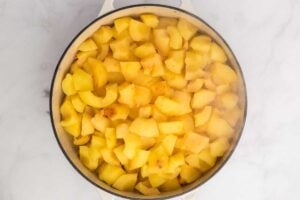
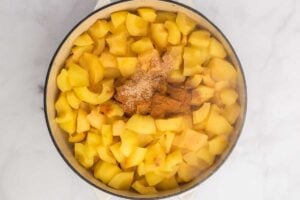
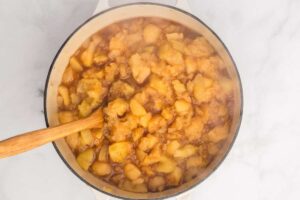
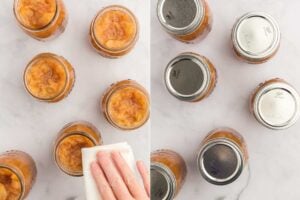
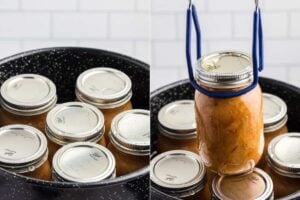
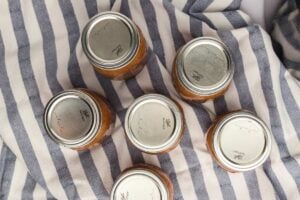












Yummy, yummy! Everyone enjoys this sauce, especially my dad who is a huge apple sauce fan Thank you for sharing.
Hi Nikki,
I’m so glad to hear that your dad loves it! There’s just something special about homemade applesauce that you can’t get from a store-bought jar, especially with all those fresh apple flavors. Thanks for the sweet comment, and happy canning! 😊
My applesauce tasted wonderful. Thank you for the recipe. I did a couple things different such as I used honey instead of sugar and I simmered my apples a little longer and the consistency was perfect without mashing. The cinnamon and nutmeg in it were wonderful. I may try a little clove in the next batch. I would recommend this recipe to all those applesauce makers.
hi sosanna! thank you so much letting me know and I am happy to hear that honey worked well!